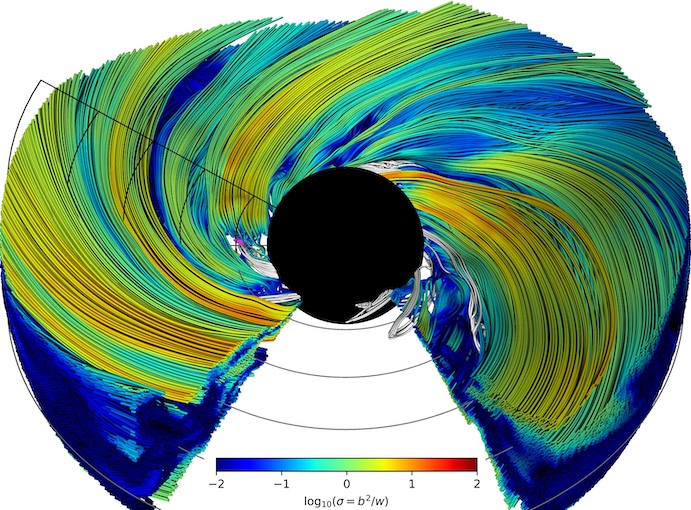
Spinning black holes accreting magnetized plasma can accumulate large magnetic fluxes across their horizons. Such magnetic fluxes convert rotational energy of the black hole into Poynting fluxes (electromagnetic momentum density), launching outflows that gradually accelerate and collimate into relativistic jets (Blandford & Znajek 1977). Magnetic fluxes at the black hole need to be supported by pressure of the accretion flow, this implies a saturation mechanism, in which excess magnetic flux is ejected in the form of magnetic flux eruptions, a characteristic feature of accretion in the MAD (Magnetically Arrested Disk) state (Tchekhovskoy et al. 2011). Recent general relativistic magnetohydrodynamical (GRMHD) numerical simulations of extremely high resolution in 3D demonstrated that such black hole flux eruptions are driven by relativistic magnetic reconnection (Ripperda et al. 2022).
This project, initially assigned by Dr. Krzysztof Nalewajko (CAMK PAN) to Mr. Mateusz Kapusta, an undergraduate student at OAUW, in collaboration with Prof. Agnieszka Janiuk from CFT PAN, was aimed to describe the trigger mechanism for black hole flux eruptions, i.e., the onset of relativistic reconnection in magnetically saturated accretion flow. To this end, we performed 3D GRMHD simulations using the Athena++ code, and investigated magnetic connectivity of the accretion flow with the black hole horizon by integrating thousands of magnetic field lines and visualizing them in 3D for hundreds of timesteps (see animations at the link below). We found that while most of the accretion flow is magnetically disconnected, doubly connected loops form chaotically within the innermost flow, introducing highly magnetized plasma that in some cases is able to trigger reconnection and flux eruption. This work includes many additional insigths: the nature of magnetically saturated accretion flow (magnetically channeled, rather than arrested or choked), typical shape of disconnected magnetic field lines, the important role of inactive equatorial current layer, additional effects in the retrograde case, rotation rates of eruption footpoints.
The above figure presents 3D rendering of magnetic field lines disconnected from the black hole horizon (represented by the black sphere), colored by local plasma magnetization (ratio of magnetic to plasma relativistic enthalpy densities). In addition, closed magnetic loops doubly connected with the horizon are shown with white lines. A very small magenta patch on the left side of the black hole represents relativistic temperature, identified as the exact location of the magnetic eruption onset. Two animated versions of such figures can be viewed at https://users.camk.edu.pl/ .
Our article was accepted for publication in Astronomy & Astrophysics: https://arxiv.org/abs/2410.08280
Text and illustration: Krzysztof Nalewajko






